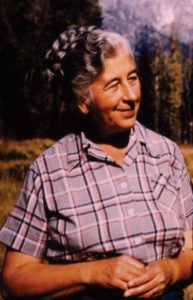Margaret “Mardy” Murie, known widely as the “Grandmother of Conservation,” was born on August 18, 1902 (died 2003). Along with her husband, Olaus Murie, she spent a lifetime—a 101-year lifetime—in the service of wilderness preservation.
Margaret Elizabeth Thomas was born in Seattle, but moved to Fairbanks, Alaska, as a girl. She became the first woman graduate of the University of Alaska-Fairbanks in 1924. Later that year, she married Olaus Murie in a 3 AM ceremony on a sternwheel boat on the Yukon River. From there, they embarked directly on a 550-mile expedition to the Brooks Range to study caribou—a honeymoon rooted in love for each other and love for nature.

Murie worked side-by-side with her husband, a biologist for the U.S. Biological Survey (now the U.S. Fish and Wildlife Service). When he was transferred to Jackson Hole, Wyoming, to study elk, they moved to the area and remained there throughout both their lives. However, their love of Alaska and wilderness continued through countless trips over a 40-year span. Together, they lobbied successfully for the creation of the Arctic National Wildlife Refuge, which President Eisenhower signed into existence in 1960.
Olaus Murie became a leader of the conservation movement in the United States, particularly engaged in the preservation of wilderness. Throughout his life, Mardy served as his assistant—in the field, the lab and the office. They raised a family that numbered, at her death, 3 children, 9 grandchildren and 12 great-grandchildren.
When Olaus died in 1963, Mardy took up the leadership of their joint work. She later said, “To live a full life, you must have something beyond your household, beyond your family, to broaden your existence.” She represented his memory when President Johnson signed the Wilderness Act, for which they both worked for many years. She lobbied extensively and effectively for the protection of lands in Alaska, resulting in the passage of the Alaska National Interest Lands Conservation Act, enacted by President Carter in 1980.
She is also known for several books about her life and the wilderness she and Olaus sought to preserve. Her autobiography, “Two in the Far North,” published in 1962, remains in print to this day.
The legacy of Mardy Murie is established in many awards that she received late in her life, including the Ding Darling Award of the National Wildlife Federation, the John Muir Award and the Audubon Award. In 1988, President Clinton presented her with the Presidential Medal of Freedom, the nation’s highest civilian recognition, for her lifetime of conservation work. In his presentation, President Clinton said the following:
For Mardy Murie wilderness was personal. She and her husband Olaus spent their honeymoon – listen to this – on a 550-mile dog sled expedition through the Brooks Mountain Range of Alaska. Fitting for a couple whose love for each other was matched only by their love of nature. After her husband died, Mrs. Murie built on their five decades of work together.
She became the prime mover in the creation of one of America’s great national treasures, the Arctic National Wildlife Refuge and blazed trails for generations of conservationists. Today amongst the fur and spruce of the high Tetons, she shares her wisdom with everyone who passes by, from ordinary hikers to the President and first lady, inspiring us all to conserve our pristine lands, and preserve her glorious legacy.
The home and ranch she shared with her husband in Moose, Wyoming, is now the Murie Center, an educational facility dedicated to bringing “people together to inspire action that protects nature. The Center is a National Historic Landmark that lies within Grand Teton National Park.
References:
Lavietes, Stuart. 2003. Margaret Murie, 101; Helped Save Wilderness. New York Times, October 23, 2003. Available at: http://www.nytimes.com/2003/10/23/us/margaret-murie-101-helped-save-wilderness.html?mcubz=1. Accessed August 17, 2017.
The Murie Center. Mardy Murie. Available at: http://www.muriecenter.org/the-murie-legacy/mardy/. Accessed August 17, 2017.
University of Alaska. Margaret Murie. UA Journey, University of Alaska. Available at: https://www.alaska.edu/uajourney/notable-people/fairbanks/margaret-murie/. Accessed August 17, 2017.
Wilderness Connect. Olaus and Mardy Murie: Alaska’s Passionate Protectors. University of Montana. Available at: http://www.wilderness.net/NWPS/Murie. Accessed August 17, 2017.
